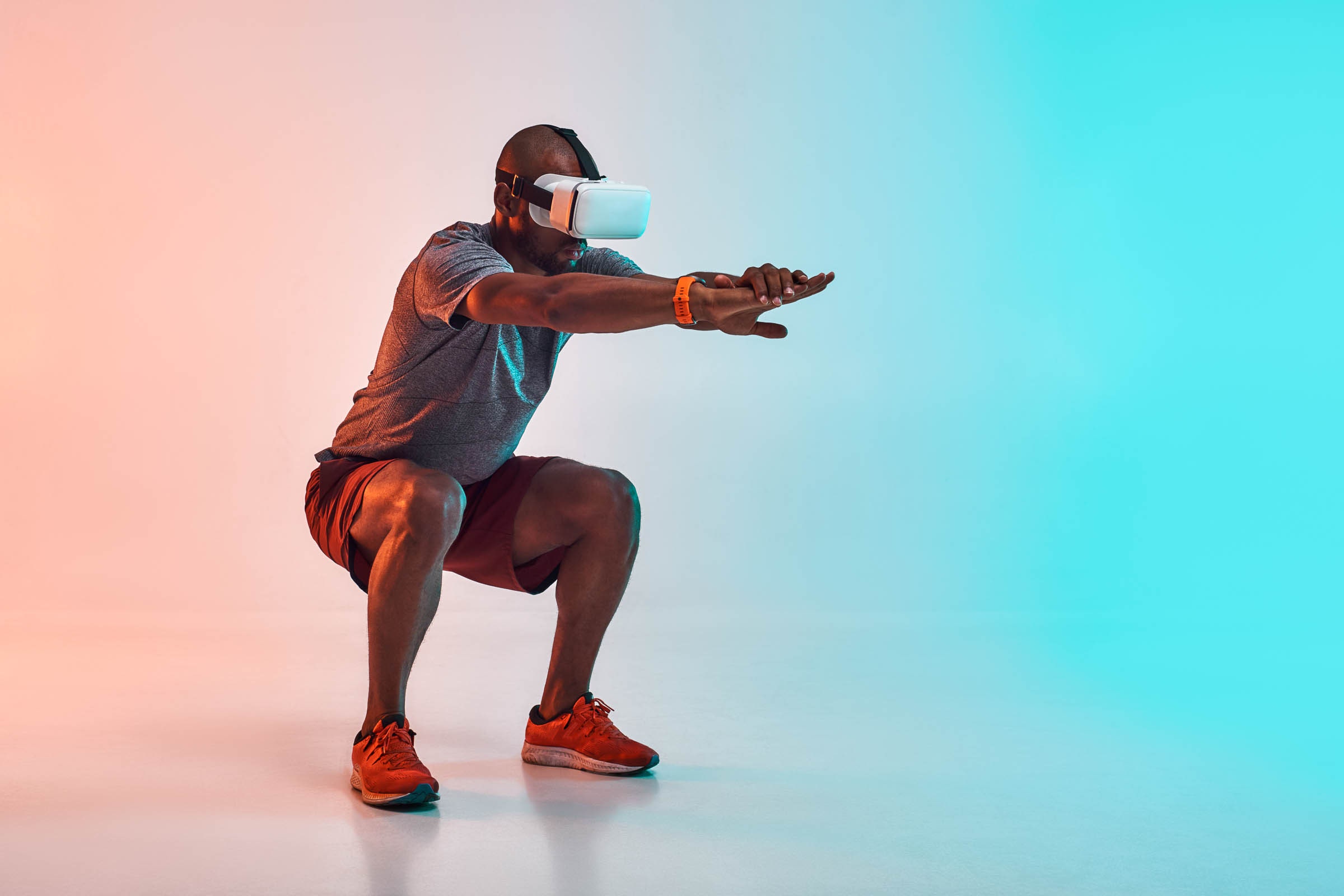Naked and Unafraid to Exercise in Virtual Reality

Get over yourself and try VR workouts already. It’s private, liberating, and doesn’t require gym shorts.
I can without bashfulness say that I have logged hundreds of hours on Beat Saber as naked as the day I was born. It was neither fetish nor high-concept performance art; it grew from simple need.
In the spring of 2018, I was trying to keep a VR startup afloat, navigating a never-ending flurry of emails, Slack messages, video calls, and tweets from the confines of my efficiency in San Mateo, California. Though typically an active person, I’d deluded myself into believing that I just didn’t have the time for luxuries like the gym and “mental health.” I did, however, make a special dispensation for staying abreast of industry happenings, and ever since a video of my friend SwanVR had gone viral, I’d been itching to play Beat Saber.
Once I started, I couldn’t stop. It quickly became habit; any time I got stressed, I’d shove my chair away from my desk and fire it up—sometimes for 90 minutes or more. In a time when I was sure I didn’t have the time for fitness, I began to establish a daily routine. My story is one of many—with folks from all over the world losing as much as 138 pounds by turning titles like Audioshield, Audio Trip, BOXVR, Creed: Rise to Glory, Holopoint, OhShape, Racket: NX, Synth Riders, Soundboxing, and Thrill of the Fight into formal exercise routines.
Re: the nudity, the laundry machines in the basement were coin-operated, and I just didn’t want to deal with sopping clothes stinking up my small apartment. I’d often muse, though, how bizarre it might have looked if anybody had witnessed it: some gangly white guy strapped into a VR headset, unselfconsciously flailing around a cramped space.
Somewhat in juxtaposition to VR’s oft-touted capacities to build empathy through embodiment, my TMI anecdote points to the power of disembodiment. So much of the modern fitness experience is wrapped up in appearance, which in turn opens the doors for insecurity and shame. It’s not just when we feel embarrassed about our out-of-shape bodies—though of course many are deterred from going to the gym because of self-esteem issues—it’s a whole host of other factors. Some are social. Am I sweating too much? Am I wearing the right clothes? Am I being laughed at? Some have to do with our sense of identity. Will I look incompetent? What if I use a machine incorrectly? I used to be able to do x at y ability—how did I let myself go? Others can be even more practical, like how often we trust ourselves to actually do laundry.
Peloton, of course, has capitalized on these concerns, building a lifestyle community around its $2,300 stationary bike (plus $40 per month subscription service). The $1,500 Mirror, a literal mirror with built-in text and video overlay functionality, is seeking to expand the trend to categories like yoga, dance, boxing, and other cardio classes. It’s easy to see how private machinery addresses many of the obstacles that keep folks from hitting the gym. Where Peloton or Mirror might offer ongoing streams of new classes, though, they are fixed physical platforms; VR fitness differentiates itself in letting users step outside the existing reality paradigm. Any mix of features can be included in an immersive game environment—and that includes how bodies are represented. In Beat Saber, the only visual correlation of your body are the two sabers, which are not “in” your hands so much as they are your hands.
There is still much to learn about the effects of different types of embodiment. It is very possible that a part of the reason I and others like me have gotten so lost in Beat Saber is that we’re never visually reminded of our bodies—even when frolicking around in our birthday suits—allowing us to push that much further, to strive for that personal record just one more time. In other VR experiences, users embody avatars or have some form of body represented. In The Thrill of the Fight, for example, users see their shredded musculature with every punch and block. Generally speaking, though, avatars and customization systems aren’t currently being built with fitness in mind—but imagine an experience where your avatar literally grows as a reflection of your exercise. One need not be a social scientist to see how this “reembodiment” could drive habit-forming engagement, which is the most crucial factor to establishing a meaningful, long-term fitness lifestyle.
The proliferation of wearables like Fitbits and Apple Watches has empowered exercisers worldwide to use their own data to improve their fitness and health, and in the process transformed the fitness industry. The recently announced virtual “smart watch” from YUR translates this interface into participating VR titles, but it embraces its virtual potential by becoming a game unto itself, using a leveling system (1-60) with new unlockable watches rewarded based on activity. This incentivizes users to add in small moments of fitness, like squats, where they might normally rest. As with any game, there’s a powerful potential here for mental conditioning—only unlike traditional videogames, triggers in VR are expressed through full-body movements. If gamers habituate their minds to subconsciously add moments of exercise into otherwise nonfitness environments, inevitably some will find that these impulses will carry over into meatspace.
Last week, industry vets Within launched Supernatural, a VR fitness platform. Like Peloton, it is a subscription service that offers daily workout routines from real trainers. Users are tasked with swinging at incoming objects with futuristic baseball bats and squatting to dodge others. These routines, which run up to 30 minutes in a variety of 360-degree environments, are synced to well-known hits and new singles alike and have been choreographed with real trainers, who greet you upon entering experiences and provide coaching throughout. Beat Saber players will clock similarities in Supernatural’s “rhythm slashing” format, but in the latter there’s a deeper intention to encourage users to establish a fitness mentality through VR—and a deeper understanding of the relationship between play and sustained physical activity. In other words, it was engineered to be a fitness platform to compete with any non-VR offering while offering the unique incentives of an immersive game. Chris Milk, Within’s cofounder and CEO, analogizes it to “playing a sport you love, but that sport is from the future, and it fits in your bedroom.” Like a pickup game that ends up turning into several hours of intense exercise, the uptick in enjoyment becomes the Trojan horse for a long-term commitment to fitness.

COURTESY OF SUPERNATURAL
Supernatural also leans into another of VR’s native strengths: customizability. It’s calibrated exactly to your body, recording your height, arm span, and squat depth during the onboarding process. Artificial intelligence continually adapts levels to your skills, allowing even familiar routines to “refresh” without ever requiring user configuration. The prioritization of power—how vigorously you swing your body through a given motion—encourages full, healthy movements specifically attuned to your body. Both of the aforementioned also minimize the impulse to rely on possibly unsafe motions or poor form. The effect has been resounding in my personal experience with Supernatural; these workouts leave me heaving—netting 500-plus calorie burns and peak heart rate BPMs in the 190s (the app can connect to wearable devices for tracking).
VR is not a replacement for all types of exercise. In a March 11 post, YUR CPO Dilan Shah wrote, “I would characterize the kind of workouts I do in VR as plyometric, and explosive in nature similar to a HIIT workout … Hypertrophic or strength benefits from lifting weights, cycling, rowing, calisthenics, and running are all different from VR workouts.” In other words, VR is best for exercise that can be done in place and doesn’t (at least at present) require weights. But this constraint sneakily doubles as a benefit; hardcore fitness fanatics who have already refined their relationships with working out are not the target market for VR exercise options (though global lockdown does serve as a synchronous backdrop for them to test alternative options). VR is ideal for those who struggle to establish and maintain this relationship long enough for it to become habit.
Just as real life offers an array of workout options, styles, and difficulties, VR experiences can be full-blown fitness titles like Supernatural or lighter-weight games that thread movement and basic fitness behaviors into gameplay. Taking YUR as an example, micro nudge mechanics can help users establish fitness mindsets, so that instead of trying to steel themselves to face the barriers of jumping into a gym lifestyle, they instead have the option of playing an immersive game with occasional exercise moments. If starting is the most important step to establishing a fitness routine, and maintaining the habit for at least a month is a close second, the psychological hacking VR offers is no small value proposition. Establishing a positive correlation between game and movement has the potential to extend into the real world—possibly even providing players the confidence to someday take on once-dreaded public workouts. In a world where we can’t even manage to stand up enough, the motivation VR can activate might mean the difference between movement and not.
Exercise is hard, and establishing a committed fitness routine is even harder. But VR is the medium most equipped to blur the boundary between movement for fun and movement for fitness—and when that power is wielded with intention, maybe there’s no meaningful difference.
Original Post: Wired, 4/30/20, Jesse Damiani
Photo Caption: VR fitness is ideal for those who struggle to establish and maintain a workout regimen long enough for it to become habit.
PHOTOGRAPH: DIMA SIDELNIKOV/GETTY IMAGES